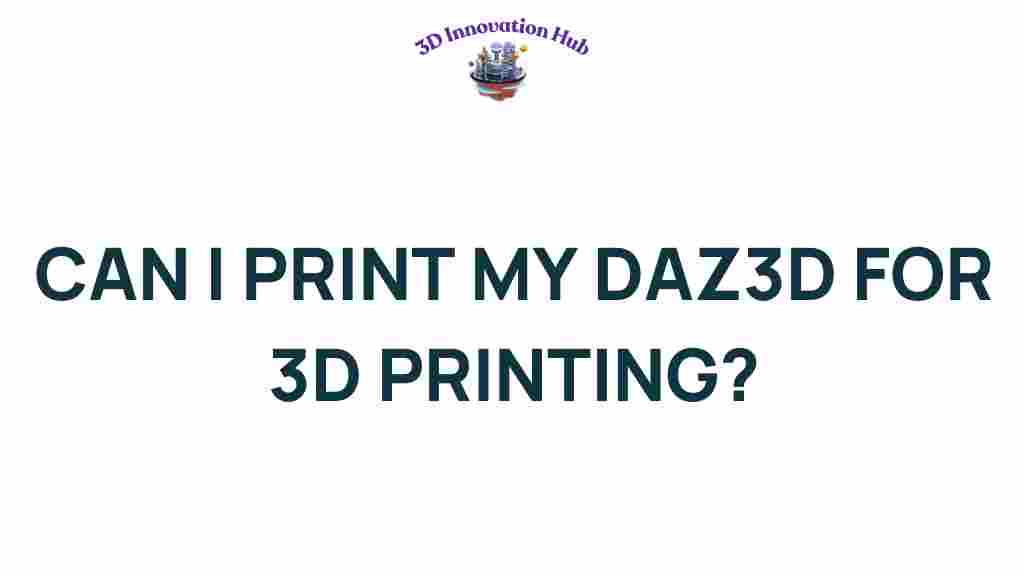Unleashing Creativity: Can You Print Your DAZ3D Models for 3D Printing?
In the realm of digital design, DAZ3D has established itself as a leading platform for creating stunning digital models. For artists and designers, the intersection of DAZ3D and 3D printing opens up an exciting frontier of creative design and innovation. This article delves into the possibilities of taking your DAZ3D creations from the screen to the physical world through 3D printing. We will explore the steps involved, the technology behind it, and the various printing techniques that can be utilized to bring your digital art to life.
Understanding DAZ3D and 3D Printing
DAZ3D is a powerful software tool that allows users to create detailed 3D models and animations. These digital models can range from characters to environments, providing a vast canvas for artists. On the other hand, 3D printing technology enables the physical manifestation of these digital designs, allowing users to produce tangible objects from computer-generated models.
By combining DAZ3D with 3D printing, artists can achieve a new level of customization and expression. Whether for personal projects, prototypes, or commercial products, the ability to convert DAZ3D models into physical items represents a significant leap in 3D art.
Step-by-Step Process for Printing Your DAZ3D Models
To successfully print your DAZ3D models, follow these steps:
1. Create Your Digital Model in DAZ3D
Start by designing your model using DAZ3D. Here are some tips for creating a model suitable for 3D printing:
- Design for Print: Ensure your model is manifold (watertight) without any holes or non-manifold edges.
- Scale: Set the model’s dimensions correctly. 3D printers have specific build volumes, so consider this while designing.
- Detailing: While intricate details are beautiful, they may not translate well to physical prints. Balance detail with printability.
2. Export Your Model
Once your model is complete, export it in a format compatible with 3D printing, such as OBJ or STL. Here’s how:
- Go to the file menu and select “Export.”
- Choose the appropriate format (OBJ or STL) based on your printer’s requirements.
- Adjust any export settings, such as scale and textures, if necessary.
3. Prepare the Model for 3D Printing
After exporting, you’ll need to prepare the model in slicing software. This software converts your model into instructions that the 3D printer can understand. Follow these steps:
- Import the Model: Open your slicing software and import the exported model file.
- Scale and Position: Adjust the size and orientation of your model for optimal printing.
- Support Structures: If your model has overhangs, add support structures to ensure stability during printing.
- Slicing: Configure print settings such as layer height, infill density, and print speed. Then slice the model.
- Export G-code: Save the sliced model as G-code, the language that communicates with the printer.
4. 3D Printing Your Model
With the G-code ready, it’s time to print:
- Set Up Your Printer: Ensure your 3D printer is calibrated and ready for the printing process.
- Load the Material: Depending on your printer, load the appropriate filament or resin.
- Start Printing: Upload the G-code to your printer and initiate the print.
5. Post-Processing
Once the printing is complete, you may need to perform some post-processing:
- Remove Supports: Carefully detach any support structures used during printing.
- Sanding and Smoothing: Smooth out rough edges and surfaces if necessary.
- Painting: Customize your model with paint or other finishes to enhance its appearance.
Troubleshooting Common Issues
While the process of printing DAZ3D models is exciting, you may encounter some issues along the way. Here are common problems and their solutions:
1. Model Not Printing Correctly
If your model doesn’t print as expected:
- Check for manifold issues. Use mesh repair tools to fix any holes or non-manifold edges in your model.
- Ensure your slicing settings are appropriate, particularly layer height and infill.
2. Warping or Curling
Models may warp or curl during printing:
- Consider using a heated bed to maintain consistent temperature.
- Increase the adhesion of your model to the print bed using glue sticks or specialized adhesives.
3. Poor Adhesion to the Print Bed
If your model doesn’t stick well to the print bed:
- Ensure the print bed is clean and leveled.
- Adjust the nozzle height in relation to the bed to improve first layer adhesion.
Conclusion: The Future of Creativity with DAZ3D and 3D Printing
The combination of DAZ3D and 3D printing offers an incredible opportunity for artists and designers to unleash their creativity. By following the steps outlined in this article, you can transform your digital models into physical masterpieces, allowing for new levels of customization and expression.
As technology continues to evolve, the possibilities for 3D art and digital design will only expand. Embrace this innovation, and explore the exciting world of 3D printing to bring your visions to life.
For further information about DAZ3D and its features, check the official site here. If you’re interested in 3D printing technology and want to learn more, visit this external resource here.
This article is in the category and created by 3D Innovation Hub Team
